There has been a lot of
« will I ? Wont I? concerning exhibitions over the last month. I was
waiting until a little later in the year for quite a few that are coming up. This
lack of enthusiasm had to stop. Today I would go to see « Out of
Africa » at the Louis Vuitton Foundation. In my usual determined way, I
got off the metro at the Jardin d’Alimentation and walked fast to the
Foundation. It opened at 11 and I wanted to be inside before the crowds.
So, I had got the opening hours mixed up. Today it opened at midday.
The question was, would I stay or would I go back into Paris and see
something else? There wasn’t too much hesitation. I stayed and read for
an hour. Of course, I was the first in and quite an experience to have
that space all to myself. Rare, I would think.
« Out of Africa » is a
collection developed but a certain John Pogozzi.
In 2007, Pigozzi
created a clothing and accessories line featuring bright colors and
prints called LimoLand, with the intention of designing clothing for
those who “Live to Create” He is also the creative director of the
brand As of 2010, LimoLine was sold in upscale department stores such
as Bloomingdale's, Barneys New York, Bergdorf Goodman, and Nordstrom and
had a boutique store in New York City. Pigozzi draws the sketches and
outsources the technical aspects of the design and creation of his line.
I found this to be an interesting background.
Pigozzi has assembled
the world’s largest collection of contemporary African art called the
Contemporary African Art Collection (CAAC – the Pigozzi Collection.
1989-2009). For the collection I was to see, he had been advised by a
certain André Magnin. His encounter with the French independent curator,
who specializes in art from non-Western cultures, and especially
sub-Saharan art. The CAAC came into being at a time when non-Western
contemporary art was largely ignored on the international scene. It was
founded shortly after the seminal exhibition "The Magicians of the Earth "
at the Beaubourg in Paris. That was the first truly international
exhibition where contemporary works from all over the world were shown
on an equal footing. I remember it very well. It was an extraordinary
experience.
What is more impressive about this collection, the
men had composed it without the help of Internet, cell ‘phones or any
other High Tech application that were around at that moment.
« The
Initiés » ( 1889- 2009) — the first part of the exhibition brought
together some 15 emblematic artists from the Jean Pigozzi’s African
collection. It was the first time that we would seem them in Paris.
A
lot I liked and a lot I didn’t like - these artists will not be
included. I will tell you a little about each artist before we go into
the second show (the same collector) called « Being There ». These works
as you will see concern present day life in Africa, concentrated on
artists who were born in the 80’s
The first gallery was a knock
out. Especially as I was alone for a few minutes. Even if I know I can
take photos as the Foundation, I still ask. The guard chatted with me
for a few minutes (he was from Africa) and it was a good introduction to
what I would see
Romuald Hazoumè.
Born in Benin, in 1962, he works between Contonou and Porto-Novo.
He
has developed an art form in close connection with his Yoruba group
(ethnic group living mostly in West Africa). Here the mask holds a
central place. He uses everyday objects adding different objects which I
found made me look even more closely as if there was a face behind the
mask! He certainly gives life back to those old jerry cans which
normally were destined for the scrap heap.

These were not really my cup of tea and yet interesting as he wrote his texts in both French and English and his own language, Lingala. He touches on a wide range of subjects. Political, economic, social and of course, corruption. Where would they find water, for instance. Each statement is something we all talk about today.
Chéri Samba. Born in 1956 in the Democratic Republic of the Congo
I walked into this…Rigoberti Nimi.
He was born in 1965 in the Democratic Republic of the Congo. As a child he built toys from scraps of wood and cardboard. I wonder how many children do that today? He was fascinated by building techniques and became a metal worker. Then he constructed, making small scale models of motorbikes…In the early 2000s he began inventing his own models using once again, salvaged material. This is quite something...
Barthélémy Tonguo, was born in Cameroun in 1966 and now works in Paris and Bandjoun.
What I saw here was a series of his drawings which are apparently inspired by his personal experiences. He says
« drawing allows me to get carried away visually, realise my desires, my fantasies… translate my pressures, pains, anxieties, once again to express LIFE »
What I see is some mysterious form of tangled bodies, joy, eroticism … what do you see?
Sebi Awa Camara was born in 1945 in Senegal.
She learnt pottery from her mother who made common, everyday objects. Awa shapes human and animal figures, breasts, rounded stomachs, hairstyles…and all those small sculptures that cling to each statue, children. The fruit of her imagination no doubt, but I found that these figures of fertility and maternity formed a universe of very strange figures and beautiful at that.
More masks but so delightful. These are done by a Calixte Dakpogan (1952, living and working in Porto-Novo).
These
really are unbridled imagination. Once again, he uses spare parts,
ballpoint pens, cheap jewellery, light bulbs, wigs… they are hilarious
in my book and very original. Look closely to see the different parts.
John Goba was born in 1944 and lives and works in Mountain Cut, Freetown (You of course understand that so many of these places I have never heard of…)
Around 30 after a « mystical » revelation, he started to make masks and then moved onto these sculptures. Each of his sculptures illustrate « stories » and only the artist has the key.
Here are a series of cities created by Bodys Isak Kingelez (1948 - 2015, in the Democratic Republic of the Congo)
There
we have a series of articulate places of political representation,
apartment blocks, sprawling commercial centres, banks and even Manhattan
in 2002.
Abu Bakarr Mansaray (1969) taught himself chemistry physics, electronics and mathematics using school text books. Not bad eh?
With this knowledge, he proclaimed himself the « Teacher » and did plans for the development of electric, mechanical and automatic systems. These are imaginary machine which produce fire, light, water cold, movement and sound. Once again as you can see, they are made of everyday objects. He is even convinced that some of his « objects » could really work.
Here are just a couple of them.

 |
|
Before entering into «Being There » I stopped and looked closely at these photos done by Ojeikere (1930-2014, Nigeria). We see a lot of woman and men with such hairstyles in Paris. When I walk up to the Gare du Nord there are a number of Hairstylists for such a « look ». Sometimes I stop and gaze but am asked to move on. My granddaughter had all her her plaited like this years ago and told me it had taken hours.
What I then found out that each hairstyle has a name, a history and a precise meaning. For everyday, for going out, for ceremonies or of now special occasion. Their names differ from region to region and serve as social markers providing information about the women who wear them. I would think that it would take a long time to understand each creation, or where came from. Only one photo was taken from face on…the rest are from the back…Did they take hours, days or even more to do?

 |
|

 |
|

 |
|

As I told you at the beginning « Being There » brings together the work of three generations of artists born or living in South Africa.
Here you walk straight into a gallery - with this…
Jane Alexander (1959 - works in Cape Town)
Her sculptures and installations deal with the universal issues of inequality, oppression and obsession for security. This is called « Infantry with Beast » and depicts 27 individuals moving along a red carpet. As you can see, they are being watched by some kind of beast. These half-animal, half-human figures are commonly known as the « African wild dog » that moves around in organised packs. It’s certainly ambiguous. Predator and Prey, hunter and hunted making a link I would think between the authoritarian, hierarchical system of the army…I said, I think it would mean this...
Another artist who lives and works in Johannesburg. David Koloane (1938). Stray dogs are plentiful in the townships and are omnipresent. He made a small film called « The Takeover »It was short and I watched it. Frightening as it tells the story of a woman attacked by dogs - and devoured -
These paintings were frightening enough.
I turned around this large installation, rather like one of the ceramic dogs. Kemang Wa Lehulere (1984...) is an artist, poet and musician. In this installation called "Green or Dog Sleep Manifesto, the artist deals with displacement and the right to own property

This is a explicit reference to the Native Lands Act passed in 1913 depriving blacks of ownership of native lands, often forcing them into exile. The dog reflects a constant threat between that and protection at times when stray dog attacks in the township of German Shephard dogs during the apartheid
Nicholas Hlobo’s work (1975) assembles fragments of material and sews and draws colourful sinus lines using multicoloured ribbons. It too has a specific meaning based on his experience as a black man from the Xhosa culture (a large South African community).
 |
|

If you came into these hanging sheets, I’m sure like me, you would say «What’s the interest ? » I saw quite a few spectators, go into the gallery and turn around and go out. To understand, it is essential to read the history.
Moshekwa Langa (1975…) was born in Bakenbur, a rural village in the Limpopo province in northern Johannesburg and a former Bantustan (territories set aside for black inhabitants during the apartheid). As a child, he discovered that his hometown did not appear on a world atlas. This is the memory source of his artwork trying to make his town exist. The DRAG PAINTINGS are wet canvases attached to the back of cars and dragged along the red earth roads surrounding Bakenberg. Marked by the irregularities on the ground, they are then suspended and resemble a topographical survey maps…when you read the text, these hanging « paintings » are very poignant!
Walking through an ally way from one gallery to the next, there are these fabric « posters » hanging on the wall. Once again, they become more interesting when one learns that they are made from a material called manga which I learnt is emblematic of globalisation. Designed in the Netherlands, manufactured industrially in Asia, imported and sold in African markets. Lawrence Lemaoana (1982) puts slogans on the fabric with headlines of newspapers reminiscent of those seen in shopping malls, road junctions and motorways. Once again, a statement….
I looked at my watch and was surprised to see that a couple of hours had gone by. So much of this work was unique and difficult to say « oh it looks like… » or even place it on a world map. Surprising…



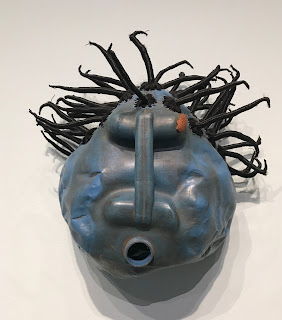
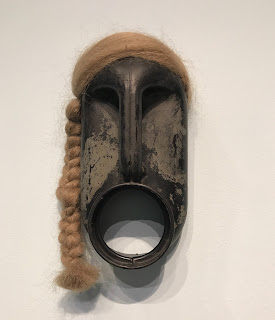

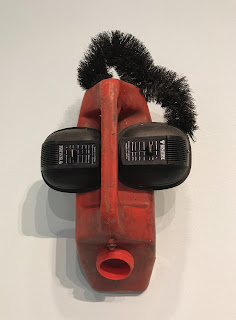


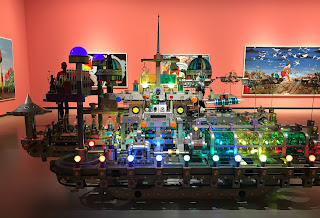
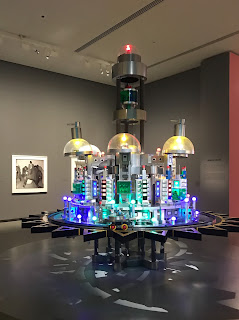


































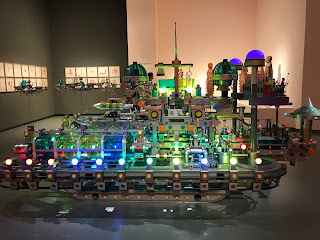


















Commentaires